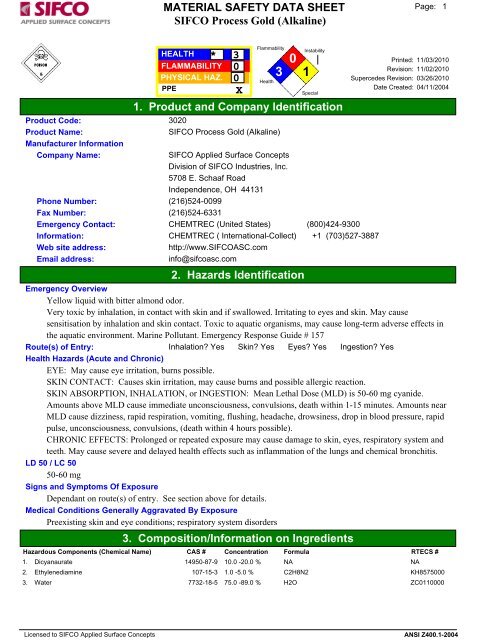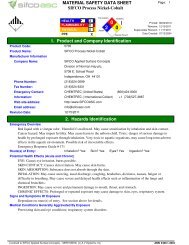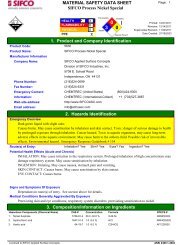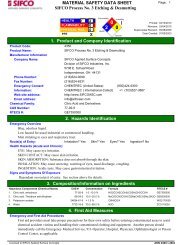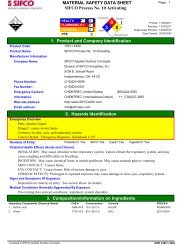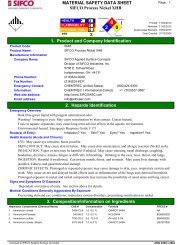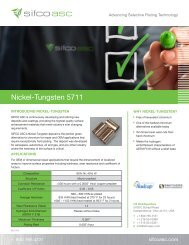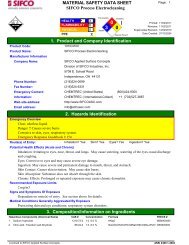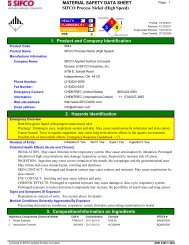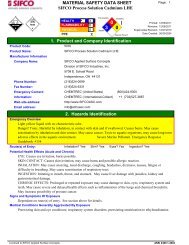MSDS-3020 - Categories
MSDS-3020 - Categories
MSDS-3020 - Categories
You also want an ePaper? Increase the reach of your titles
YUMPU automatically turns print PDFs into web optimized ePapers that Google loves.
MATERIAL SAFETY DATA SHEET<br />
SIFCO Process Gold (Alkaline)<br />
Page:<br />
1<br />
HEALTH 3<br />
FLAMMABILITY 0<br />
PHYSICAL HAZ.<br />
PPE<br />
*<br />
0<br />
X<br />
Flammability<br />
Health<br />
3<br />
0<br />
Instability<br />
1<br />
Special<br />
1. Product and Company Identification<br />
Product Code: <strong>3020</strong><br />
Product Name:<br />
SIFCO Process Gold (Alkaline)<br />
Manufacturer Information<br />
Company Name:<br />
SIFCO Applied Surface Concepts<br />
Division of SIFCO Industries, Inc.<br />
5708 E. Schaaf Road<br />
Independence, OH 44131<br />
Phone Number: (216)524-0099<br />
Fax Number: (216)524-6331<br />
Emergency Contact: CHEMTREC (United States) (800)424-9300<br />
Information: CHEMTREC ( International-Collect) +1 (703)527-3887<br />
Web site address:<br />
http://www.SIFCOASC.com<br />
Email address:<br />
info@sifcoasc.com<br />
2. Hazards Identification<br />
Printed: 11/03/2010<br />
Revision: 11/02/2010<br />
Supercedes Revision: 03/26/2010<br />
Date Created: 04/11/2004<br />
Emergency Overview<br />
Yellow liquid with bitter almond odor.<br />
Very toxic by inhalation, in contact with skin and if swallowed. Irritating to eyes and skin. May cause<br />
sensitisation by inhalation and skin contact. Toxic to aquatic organisms, may cause long-term adverse effects in<br />
the aquatic environment. Marine Pollutant. Emergency Response Guide # 157<br />
Route(s) of Entry: Inhalation? Yes Skin? Yes Eyes? Yes Ingestion? Yes<br />
Health Hazards (Acute and Chronic)<br />
EYE: May cause eye irritation, burns possible.<br />
SKIN CONTACT: Causes skin irritation, may cause burns and possible allergic reaction.<br />
SKIN ABSORPTION, INHALATION, or INGESTION: Mean Lethal Dose (MLD) is 50-60 mg cyanide.<br />
Amounts above MLD cause immediate unconsciousness, convulsions, death within 1-15 minutes. Amounts near<br />
MLD cause dizziness, rapid respiration, vomiting, flushing, headache, drowsiness, drop in blood pressure, rapid<br />
pulse, unconsciousness, convulsions, (death within 4 hours possible).<br />
CHRONIC EFFECTS: Prolonged or repeated exposure may cause damage to skin, eyes, respiratory system and<br />
teeth. May cause severe and delayed health effects such as inflammation of the lungs and chemical bronchitis.<br />
LD 50 / LC 50<br />
50-60 mg<br />
Signs and Symptoms Of Exposure<br />
Dependant on route(s) of entry. See section above for details.<br />
Medical Conditions Generally Aggravated By Exposure<br />
Preexisting skin and eye conditions; respiratory system disorders<br />
3. Composition/Information on Ingredients<br />
Hazardous Components (Chemical Name)<br />
CAS # Concentration Formula RTECS #<br />
1. Dicyanaurate 14950-87-9 10.0 -20.0 % NA<br />
NA<br />
2. Ethylenediamine 107-15-3 1.0 -5.0 % C2H8N2<br />
KH8575000<br />
3. Water 7732-18-5 75.0 -89.0 % H2O<br />
ZC0110000<br />
Licensed to SIFCO Applied Surface Concepts<br />
ANSI Z400.1-2004
MATERIAL SAFETY DATA SHEET<br />
SIFCO Process Gold (Alkaline)<br />
4. First Aid Measures<br />
Page:<br />
Printed: 11/03/2010<br />
Revision: 11/02/2010<br />
Supercedes Revision: 03/26/2010<br />
Emergency and First Aid Procedures<br />
GENERAL INFORMATION<br />
Move the exposed person to fresh air at once. When breathing is difficult, properly trained personnel may assist<br />
affected person by administering 100% oxygen. Get medical attention immediately! CAUTION! First aid<br />
personnel must be aware of own risk during rescue!<br />
INHALATION:<br />
Move the exposed person to fresh air at once. Get medical attention. Provide rest, warmth and fresh air. When<br />
breathing is difficult, properly trained personnel may assist affected person by administering oxygen.<br />
INGESTION:<br />
NEVER MAKE AN UNCONSCIOUS PERSON VOMIT OR DRINK FLUIDS!<br />
Remove victim immediately from source of exposure. Get medical attention immediately!<br />
SKIN CONTACT:<br />
Remove affected person from source of contamination. Remove contaminated clothing. Wash the skin<br />
immediately with soap and water. Get medical attention promptly if symptoms occur after washing.<br />
EYE CONTACT:<br />
Remove victim immediately from source of exposure. Make sure to remove any contact lenses from the eyes<br />
before rinsing. Promptly wash eyes with plenty of water while lifting the eye lids. Immediately rinse with water<br />
for several minutes. Get medical attention if any discomfort continues.<br />
Note to Physician<br />
SPECIFIC NOTES FOR CYANIDE TREATMENT: If the casualty is breathing, break 2 amyl nitrite tablets<br />
under the casualty's nose so the vapour is inhaled. Kelo-cyanor should only be used by trained personnel.<br />
Kelo-cyanor is extremely dangerous when administered to casualties NOT suffering from cyanide poisoning.<br />
5. Fire Fighting Measures<br />
Flammability Classification: Material Will Not Burn<br />
Flash Pt:<br />
NA<br />
Explosive Limits: LEL: None UEL: None<br />
Autoignition Pt:<br />
NA<br />
Special Fire Fighting Procedures<br />
Use NIOSH/MSHA approved positive-pressure self?contained breathing apparatus. Structural fire fighters'<br />
protective clothing WILL NOT provide adequate protection.<br />
Unusual Fire and Explosion Hazards<br />
Containers can build up pressure and burst if exposed to heat (fire). Water runoff can cause environmental<br />
damage. Dike area for later disposal.<br />
Suitable Extinguishing Media<br />
Dry chemical, water spray, and regular foam.<br />
Unsuitable Extinguishing Media<br />
6. Accidental Release Measures<br />
Steps To Be Taken In Case Material Is Released Or Spilled<br />
Wear necessary protective equipment. Do not contaminate water sources or sewer.<br />
DO NOT TOUCH SPILLED MATERIAL!<br />
Avoid contact with skin or inhalation of spillage, dust or vapor. Should be prevented from entering drains. Absorb<br />
in vermiculite, dry sand or earth and place into containers. Containers with collected spillage must be properly<br />
labelled with correct contents and hazard symbol.<br />
2<br />
Licensed to SIFCO Applied Surface Concepts<br />
ANSI Z400.1-2004
MATERIAL SAFETY DATA SHEET<br />
SIFCO Process Gold (Alkaline)<br />
7. Handling and Storage<br />
Page:<br />
Printed: 11/03/2010<br />
Revision: 11/02/2010<br />
Supercedes Revision: 03/26/2010<br />
Precautions To Be Taken in Handling<br />
Use "buddy system" when working with chemicals. Do not get in eyes, on skin, on clothing. Do not breathe<br />
vapor, mist or gas. Use with adequate ventilation. Wash thoroughly after handling. Triple rinse container clean<br />
before discarding. Put nothing else in this container.<br />
Precautions To Be Taken in Storing<br />
Keep container tightly closed in upright position. Store at 60-90°F away from incompatible materials and physical<br />
hazards. Do not remove or deface container labels.<br />
Other Precautions<br />
Keep in original container. Store in locked, well ventilated room and isolated from acids.<br />
8. Exposure Controls/Personal Protection<br />
Hazardous Components (Chemical Name)<br />
CAS # OSHA PEL ACGIH TLV<br />
Other Limits<br />
1. Dicyanaurate 14950-87-9 5 mg/m3<br />
2. Ethylenediamine 107-15-3 10 PPM<br />
10 ppm<br />
3. Water 7732-18-5<br />
Respiratory Equipment (Specify Type)<br />
If engineering controls are not feasible, the respiratory protection program must comply with OSHA 29 CFR<br />
1910.134<br />
Eye Protection<br />
Face shield and safety glasses w/side shields or splash-proof chemical goggles. Do not wear contact lenses. Eye<br />
wash station, safety shower, washing facilities near work area.<br />
Protective Gloves<br />
Nitrile, neoprene, vinyl, latex gloves.<br />
Other Protective Clothing<br />
Impervious boots, apron, protective clothing as required by job conditions.<br />
Ventilation<br />
Local exhaust ventilation is required to meet the permissible exposure limits (PEL) during the use of this product.<br />
Work/Hygienic/Maintenance Practices<br />
DO NOT SMOKE IN WORK AREA! Wash at the end of each work shift and before eating, smoking and using<br />
the toilet. Promptly remove any clothing that becomes contaminated. Wash promptly with soap & water if skin<br />
becomes contaminated. Use appropriate skin cream to prevent drying of skin. When using do not eat, drink or<br />
smoke.<br />
9. Physical and Chemical Properties<br />
Physical States: [ ] Gas [ X ] Liquid [ ] Solid<br />
Melting Point: = 212.00 F (100.0 C)<br />
Autoignition Pt:<br />
NA<br />
Flash Pt:<br />
NA<br />
Explosive Limits: LEL: None UEL: None<br />
Specific Gravity (Water = 1): 1.090 - 1.100<br />
Evaporation Rate (vs Butyl < 1<br />
Acetate=1):<br />
Solubility in Water:<br />
Complete<br />
pH: 9.5 - 10.3<br />
Appearance and Odor<br />
Yellow liquid with the odor of bitter almonds.<br />
3<br />
Licensed to SIFCO Applied Surface Concepts<br />
ANSI Z400.1-2004
MATERIAL SAFETY DATA SHEET<br />
SIFCO Process Gold (Alkaline)<br />
10. Stability and Reactivity<br />
Stability: Unstable [ ] Stable [ X ]<br />
Conditions To Avoid - Instability<br />
Stable under normal ambient conditions in tightly closed containers. Avoid overheating.<br />
Incompatibility - Materials To Avoid<br />
Acids, chlorates, nitrites, oxidizers, and magnesium.<br />
Hazardous Decomposition Or Byproducts<br />
Hydrogen Cyanide (HCN)<br />
Possibility of Hazardous Reactions: Will occur [ ] Will not occur [ X ]<br />
Conditions To Avoid - Hazardous Reactions<br />
Avoid contact with acids and oxidising substances. Generates very toxic gas in contact with acid.<br />
Not Available<br />
Carcinogenicity/Other Information<br />
11. Toxicological Information<br />
Page:<br />
Printed: 11/03/2010<br />
Revision: 11/02/2010<br />
Supercedes Revision: 03/26/2010<br />
Hazardous Components (Chemical Name)<br />
CAS # NTP IARC ACGIH OSHA<br />
1. Dicyanaurate 14950-87-9<br />
2. Ethylenediamine 107-15-3<br />
A4<br />
3. Water 7732-18-5<br />
Carcinogenicity: NTP? No IARC Monographs? No OSHA Regulated? No<br />
12. Ecological Information<br />
ECOTOXICITY<br />
Dangerous for the environment: May cause long-term adverse effects in the aquatic environment.<br />
13. Disposal Considerations<br />
Waste Disposal Method<br />
Ship to approved treatment/disposal facility, or precious metal reclaimer. Dispose of according to local, state, and<br />
federal regulations. Follow the applicable regulations for disposal of empty containers and rinse water. The<br />
disposal information applies to the material as manufactured. Contamination may affect the disposal<br />
requirements. The responsibility for proper waste disposal is with the generator of the waste.<br />
RCRA Waste ID Code:<br />
F007<br />
Additional Disposal Information<br />
D003<br />
LAND TRANSPORT (US DOT)<br />
DOT Proper Shipping Name<br />
DOT Hazard Class: 6.1<br />
DOT Hazard Label:<br />
POISON<br />
UN/NA Number:<br />
UN3287<br />
Packing Group:<br />
II<br />
LAND TRANSPORT (Canadian TDG)<br />
UN Number: 3287<br />
Packing Group:<br />
II<br />
LAND TRANSPORT (European ADR/RID)<br />
UN Number: 3287<br />
Packing Group:<br />
II<br />
14. Transport Information<br />
UN3287, TOXIC LIQUID, INORGANIC, N.O.S.<br />
(Dicyanoaurate) 6.1, PG II - ERG 151<br />
4<br />
Licensed to SIFCO Applied Surface Concepts<br />
ANSI Z400.1-2004
MATERIAL SAFETY DATA SHEET<br />
SIFCO Process Gold (Alkaline)<br />
Page: 5<br />
Printed: 11/03/2010<br />
Revision: 11/02/2010<br />
Supercedes Revision: 03/26/2010<br />
MARINE TRANSPORT (IMDG/IMO)<br />
UN Number: 3287<br />
Packing Group:<br />
II<br />
Marine Pollutant:<br />
Yes<br />
US EPA SARA Title III<br />
15. Regulatory Information<br />
Hazardous Components (Chemical Name)<br />
CAS # Sec.302 (EHS) Sec.304 RQ Sec.313 (TRI) Sec.110<br />
1. Dicyanaurate 14950-87-9 No<br />
No<br />
No<br />
No<br />
2. Ethylenediamine 107-15-3 Yes 10000 LB Yes 5000 LB No<br />
No<br />
3. Water 7732-18-5 No<br />
No<br />
No<br />
No<br />
US EPA CAA, CWA, TSCA<br />
Hazardous Components (Chemical Name)<br />
CAS # EPA CAA EPA CWA NPDES EPA TSCA CA PROP 65<br />
1. Dicyanaurate 14950-87-9 HAP, ODC () No<br />
No<br />
No<br />
2. Ethylenediamine 107-15-3 HAP, ODC () Yes<br />
Inventory<br />
No<br />
3. Water 7732-18-5 HAP, ODC () No<br />
Inventory<br />
No<br />
SARA (Superfund Amendments and<br />
Reauthorization Act of 1986) Lists:<br />
Sec.302: EPA SARA Title III Section 302 Extremely Hazardous Chemical with TPQ. * indicates 10000<br />
LB TPQ if not volatile.<br />
Sec.304: EPA SARA Title III Section 304: CERCLA Reportable + Sec.302 with Reportable Quantity. **<br />
indicates statutory RQ.<br />
Sec.313:<br />
EPA SARA Title III Section 313 Toxic Release Inventory. Note: -Cat indicates a member of a<br />
chemical category.<br />
Sec.110:<br />
EPA SARA 110 Superfund Site Priority Contaminant List<br />
TSCA (Toxic Substances Control<br />
Act) Lists:<br />
Inventory:<br />
Chemical Listed in the TSCA Inventory.<br />
5A(2):<br />
Chemical Subject to Significant New Rules (SNURS)<br />
6A: Commercial Chemical Control Rules<br />
8A: Toxic Substances Subject To Information Rules on Production<br />
8A CAIR:<br />
Comprehensive Assessment Information Rules - (CAIR)<br />
8A PAIR:<br />
Preliminary Assessment Information Rules - (PAIR)<br />
8C: Records of Allegations of Significant Adverse Reactions<br />
8D: Health and Safety Data Reporting Rules<br />
8D TERM:<br />
Health and Safety Data Reporting Rule Terminations<br />
12(b):<br />
Notice of Export<br />
Other Important Lists:<br />
CWA NPDES:<br />
EPA Clean Water Act NPDES Permit Chemical<br />
CAA HAP:<br />
EPA Clean Air Act Hazardous Air Pollutant<br />
CAA ODC:<br />
EPA Clean Air Act Ozone Depleting Chemical (1=CFC, 2=HCFC)<br />
CA PROP 65: California Proposition 65<br />
International Regulatory Lists:<br />
EPA Hazard <strong>Categories</strong>:<br />
This material meets the EPA 'Hazard <strong>Categories</strong>' defined for SARA Title III Sections 311/312 as indicated:<br />
[X] Yes [ ] No Acute (immediate) Health Hazard<br />
[X] Yes [ ] No Chronic (delayed) Health Hazard<br />
[ ] Yes [X] No Fire Hazard<br />
[ ] Yes [X] No Sudden Release of Pressure Hazard<br />
[X] Yes [ ] No Reactive Hazard<br />
Licensed to SIFCO Applied Surface Concepts<br />
ANSI Z400.1-2004
Regulatory Information<br />
U.S. FEDERAL REGULATIONS:<br />
1. Supplier Notification about toxic Chemicals.<br />
MATERIAL SAFETY DATA SHEET<br />
SIFCO Process Gold (Alkaline)<br />
Page: 6<br />
Printed: 11/03/2010<br />
Revision: 11/02/2010<br />
Supercedes Revision: 03/26/2010<br />
SIFCO Applied Surface Concepts is required to inform you, that this product contains a toxic chemical or<br />
chemicals subject to the reporting requirements of Section 313 of Title III of the Superfund Amendments and<br />
Reauthorization Act of 1986 and 40 CFR Part 372, if specified annual thresholds are met or exceeded.<br />
Toxic Chemical CAS # Wt.%(Maximum)<br />
Dicyanaurate - 14950-87-9 -- (20)<br />
Ethylenediamine - 107-15-3 -- (5)<br />
Your other suppliers of trade name products or mixtures containing section 313 chemicals must also notify you.<br />
If you repackage or otherwise redistribute this product to industrial customers you are required to furnish similar<br />
notification to them.<br />
2. CERCLA and EPCRA:<br />
Threshold Planning Quantity : 100 Lbs<br />
(Release) Reportable Quantity: > 21 liters<br />
Extremely Hazardous Substances: Ethylenediamine<br />
3. EPCRA Hazard <strong>Categories</strong>:<br />
Immediate (Acute) Health: Yes<br />
Delayed (Chronic) Health: Yes<br />
Fire: No<br />
Sudden release of Pressure: No<br />
Reactivity: Yes<br />
4. TSCA Statement.<br />
All ingredients of this product are listed under the Toxic Substances Control Act (TSCA).<br />
5. ODS Certification.<br />
This product does not contain and is not manufactured with Ozone Depleting Substances (ODS).<br />
6. VOC Certification.<br />
This product does not contain any Volatile Organic Compounds (VOC).<br />
7. PCB Certification.<br />
This product does not contain any polychlorinated biphenyls (PCB).<br />
STATE REGULATIONS:<br />
California Prop. 65: Not applicable<br />
INTERNATIONAL REGULATIONS<br />
WHMIS Classification: Class D1A , E<br />
Licensed to SIFCO Applied Surface Concepts<br />
ANSI Z400.1-2004
MATERIAL SAFETY DATA SHEET<br />
SIFCO Process Gold (Alkaline)<br />
Page: 7<br />
Printed: 11/03/2010<br />
Revision: 11/02/2010<br />
Supercedes Revision: 03/26/2010<br />
16. Other Information<br />
Company Policy or Disclaimer<br />
DISCLAIMER:<br />
This information is believed to be accurate and represents the best information currently available to us. However,<br />
we make no warrenty of merchantability or any other warranty, express or implied, with respect to such<br />
information, and we assume no liability resulting from its use. Users should make their own investigations to<br />
determine the suitability of the information for their particular purposes.<br />
Licensed to SIFCO Applied Surface Concepts<br />
ANSI Z400.1-2004


